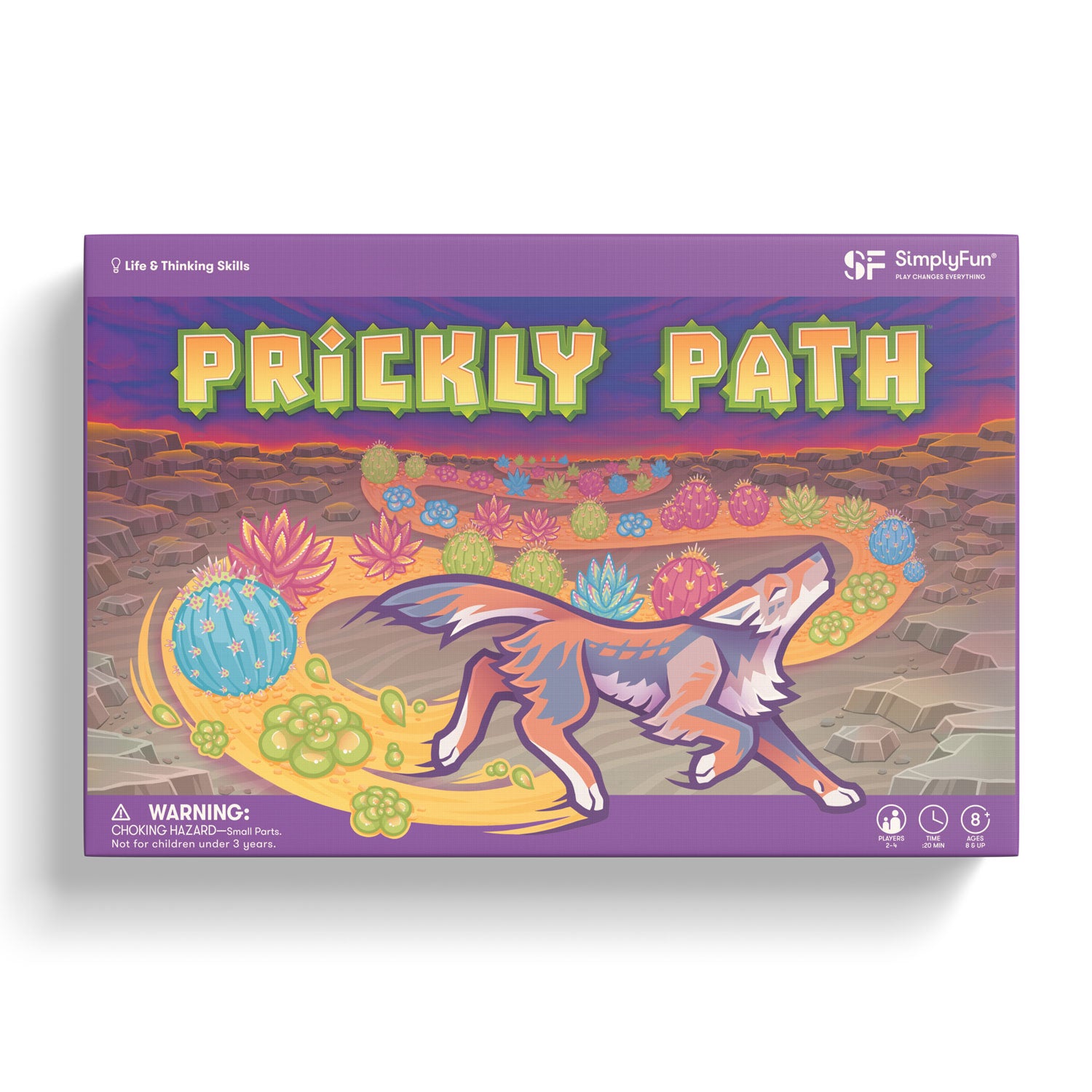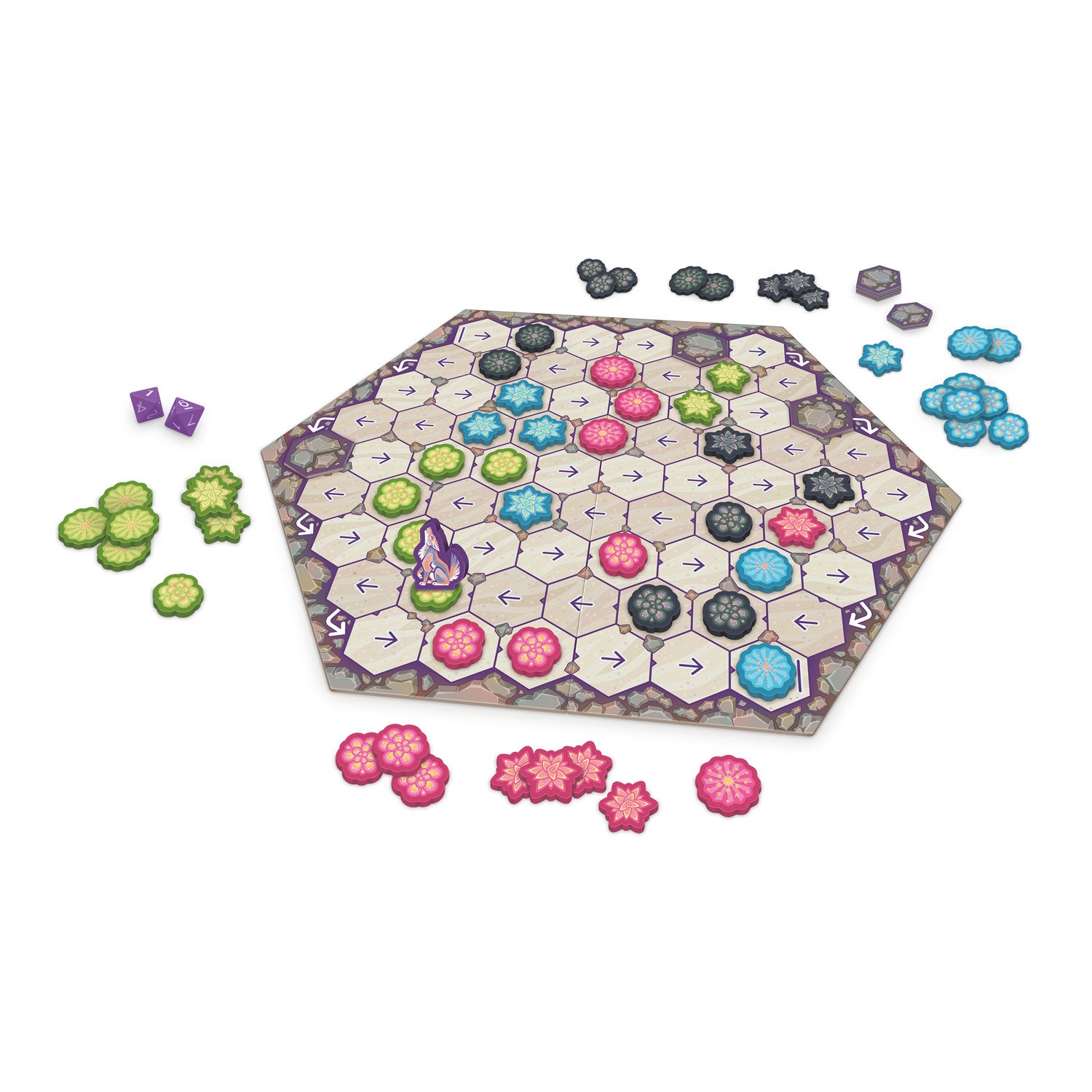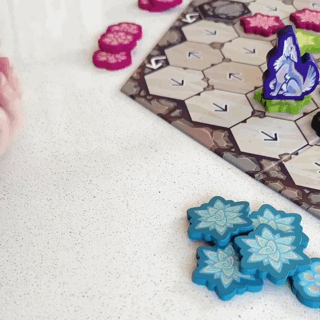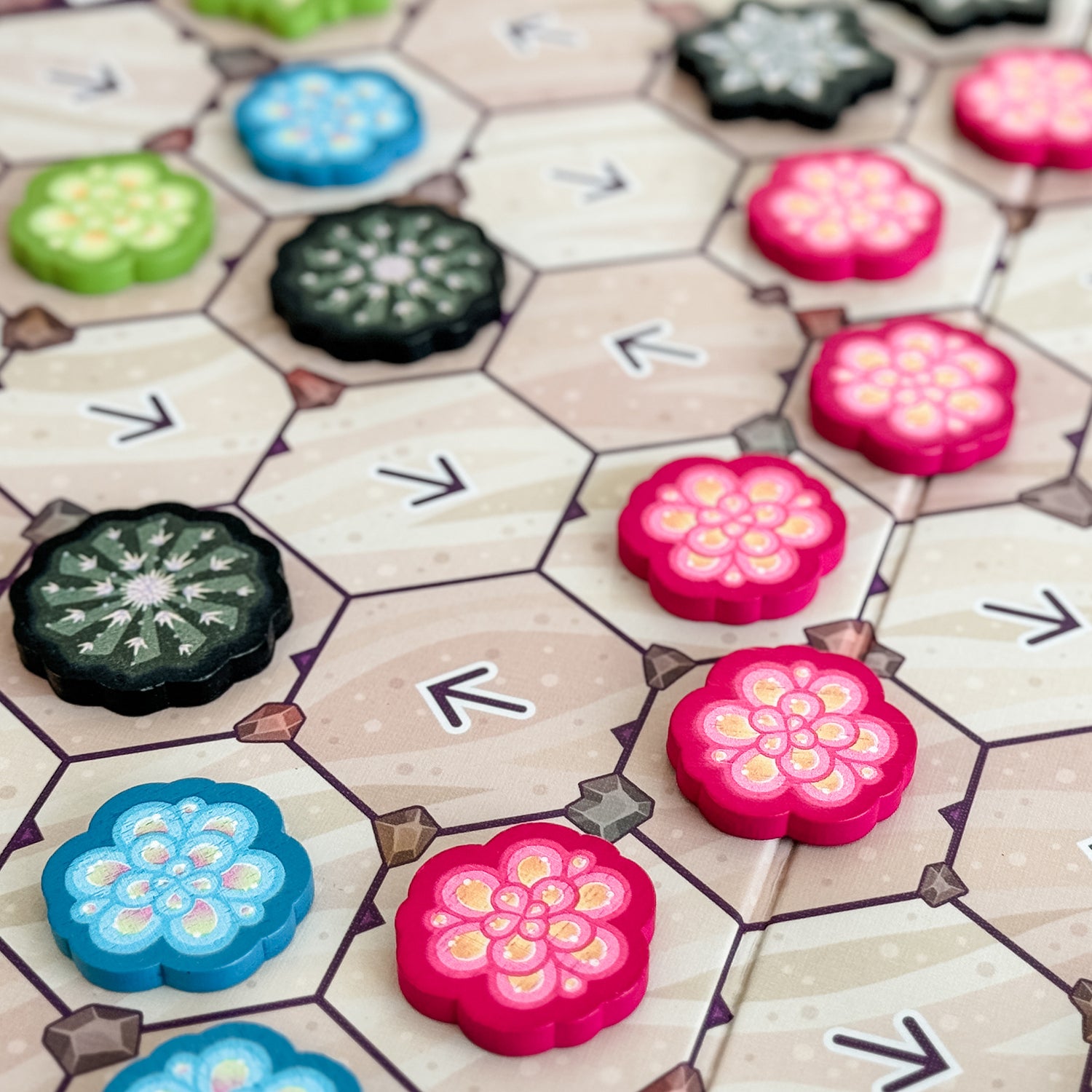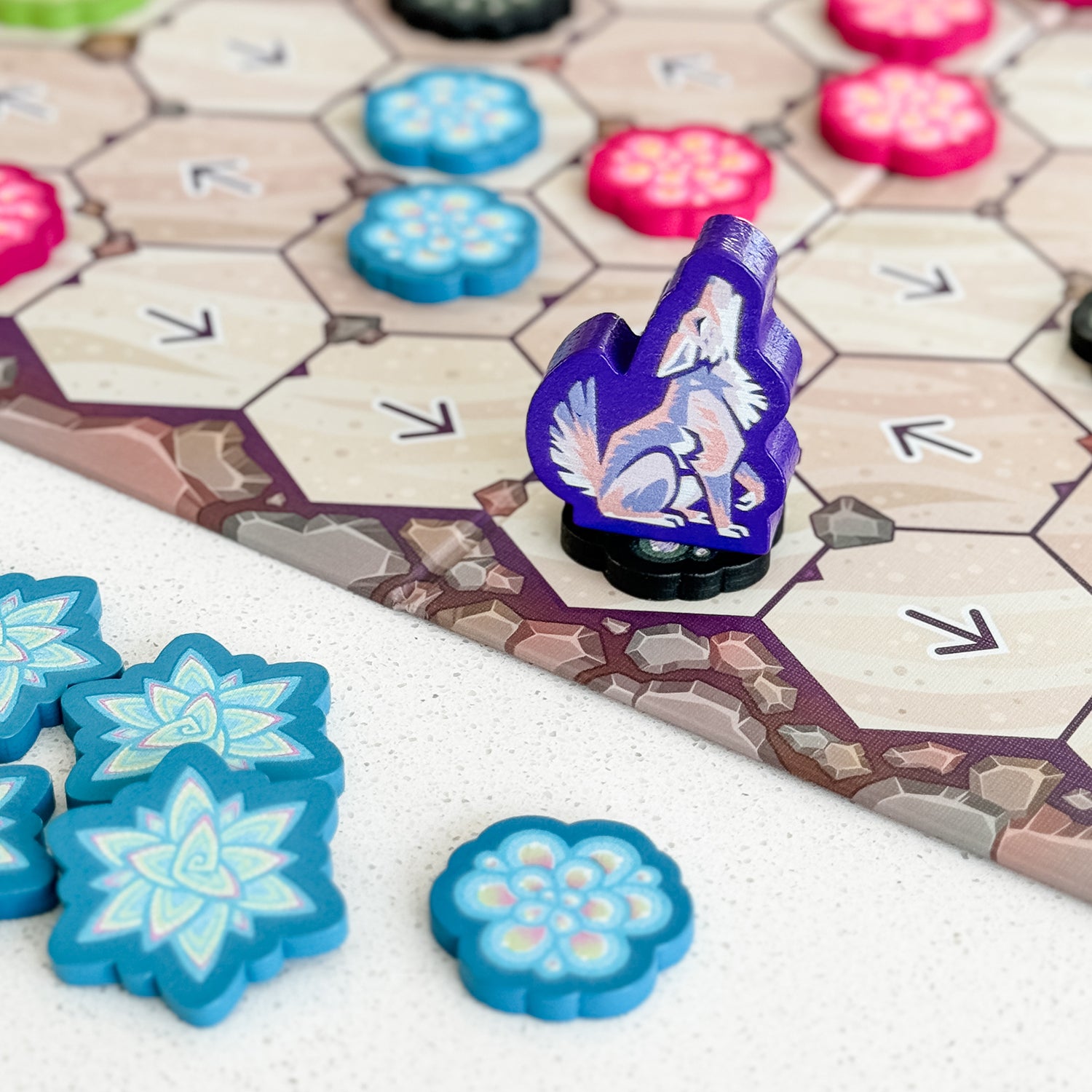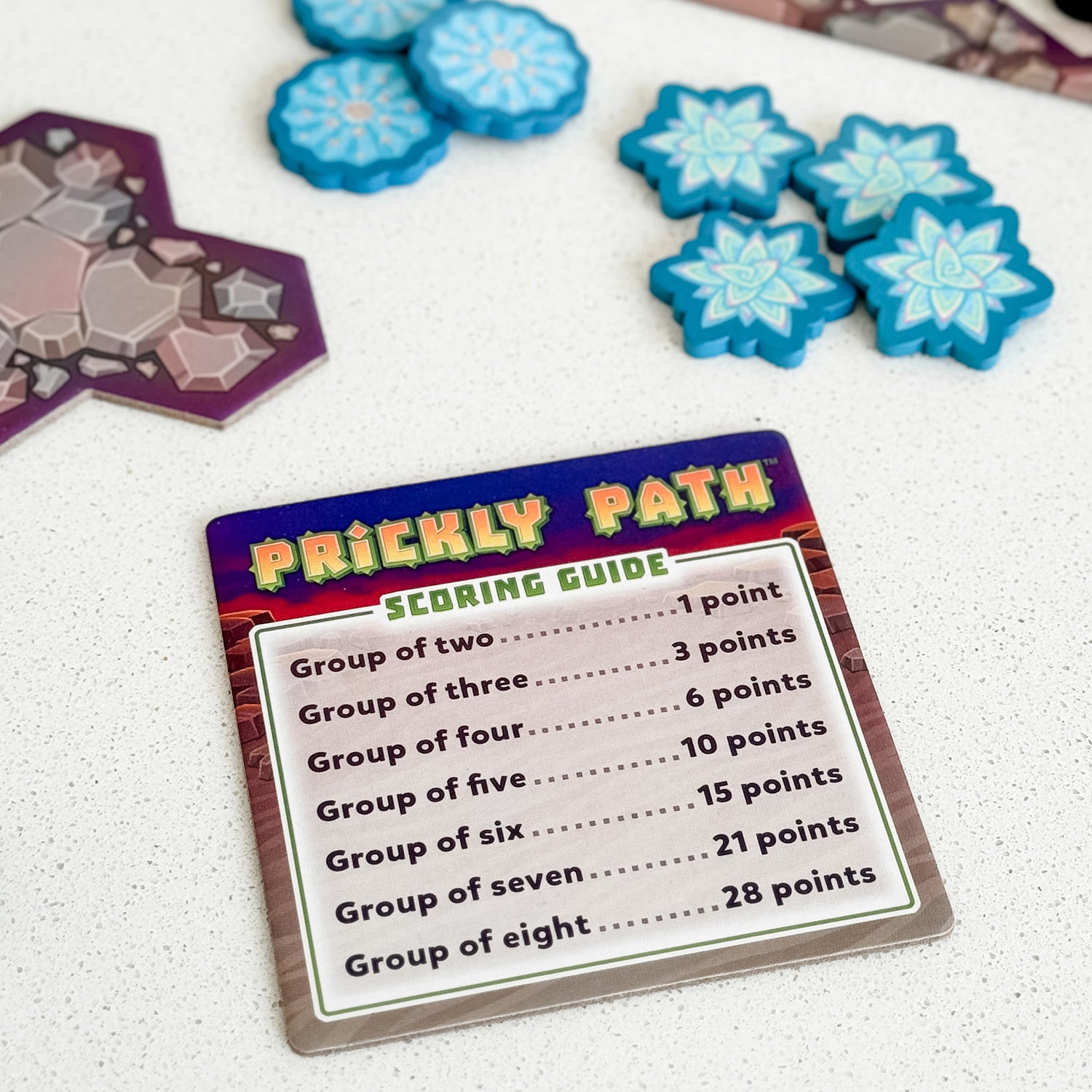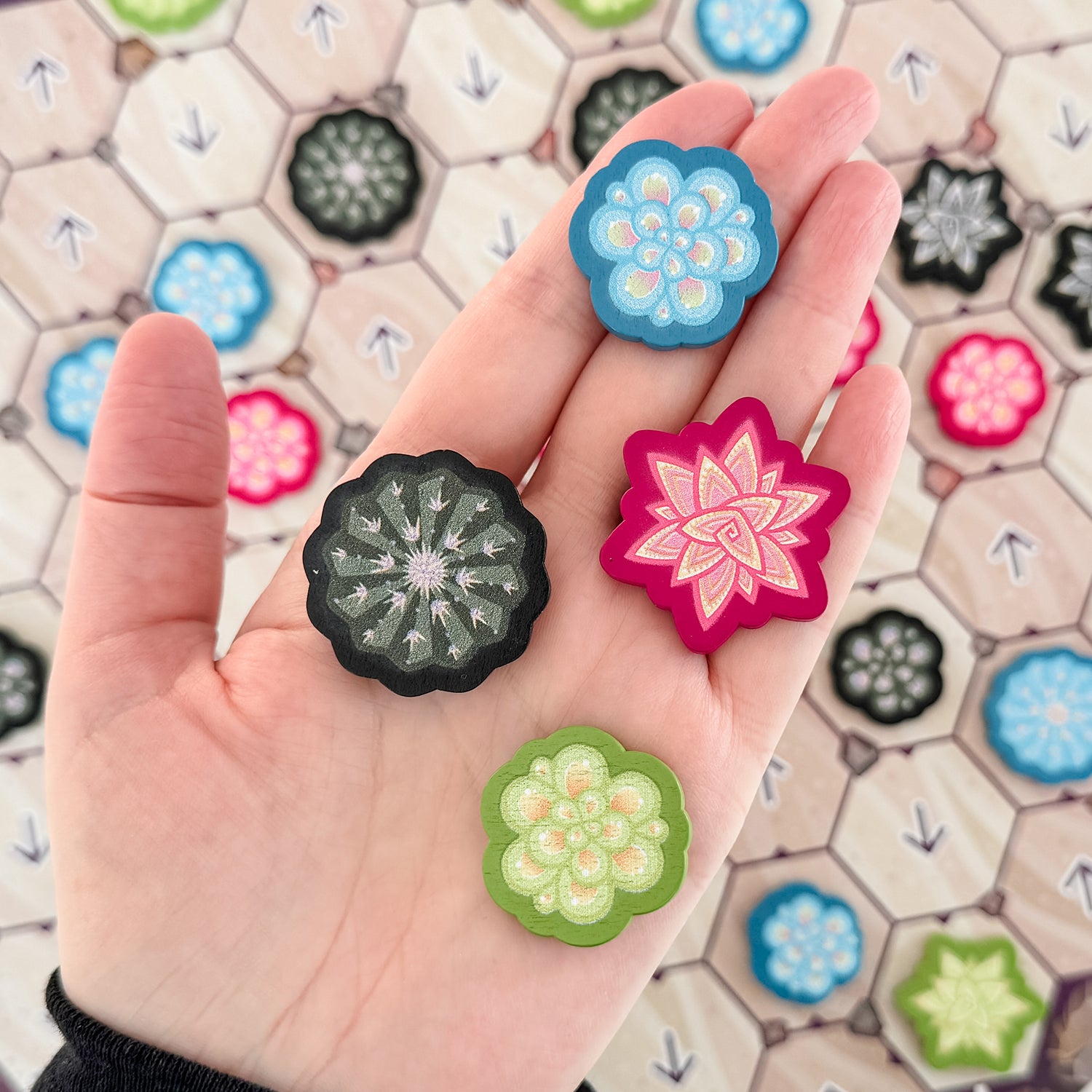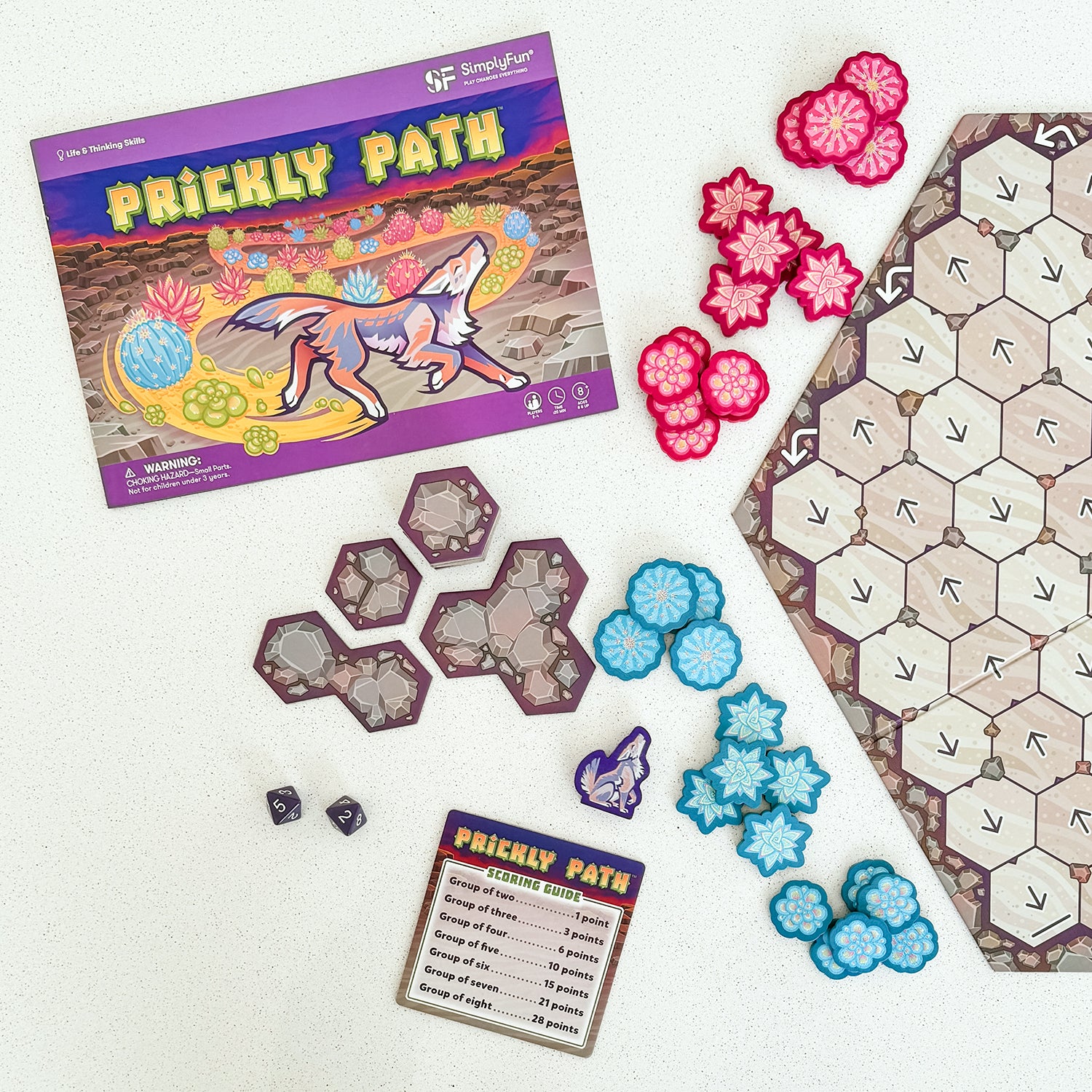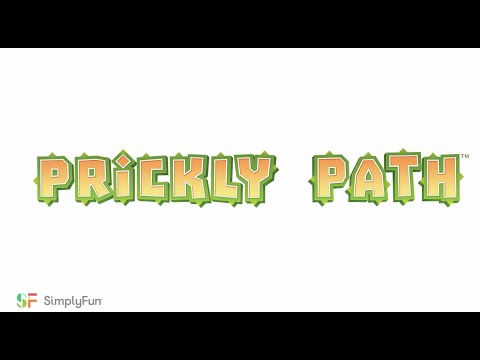Prickly Path
Prickly Path
2-4 players • 20 min • 8 & up
Focus: Strategy
Couldn't load pickup availability
Skills: Strategy, Decision Making
Game Includes
Game Includes
- 32 Succulent Cactus Pieces (8 in each player color)
- 28 Aloe Cactus Pieces (7 in each player color)
- 24 Barrel Cactus Pieces (6 in each player color)
- 11 Skipping Stones
- 2 Big Skipping Stones
- 2 Eight-sided Dice
- 1 Coyote Pawn
- 1 Gameboard
- 1 Scoring Legend Card
- 1 Rules Booklet
Share
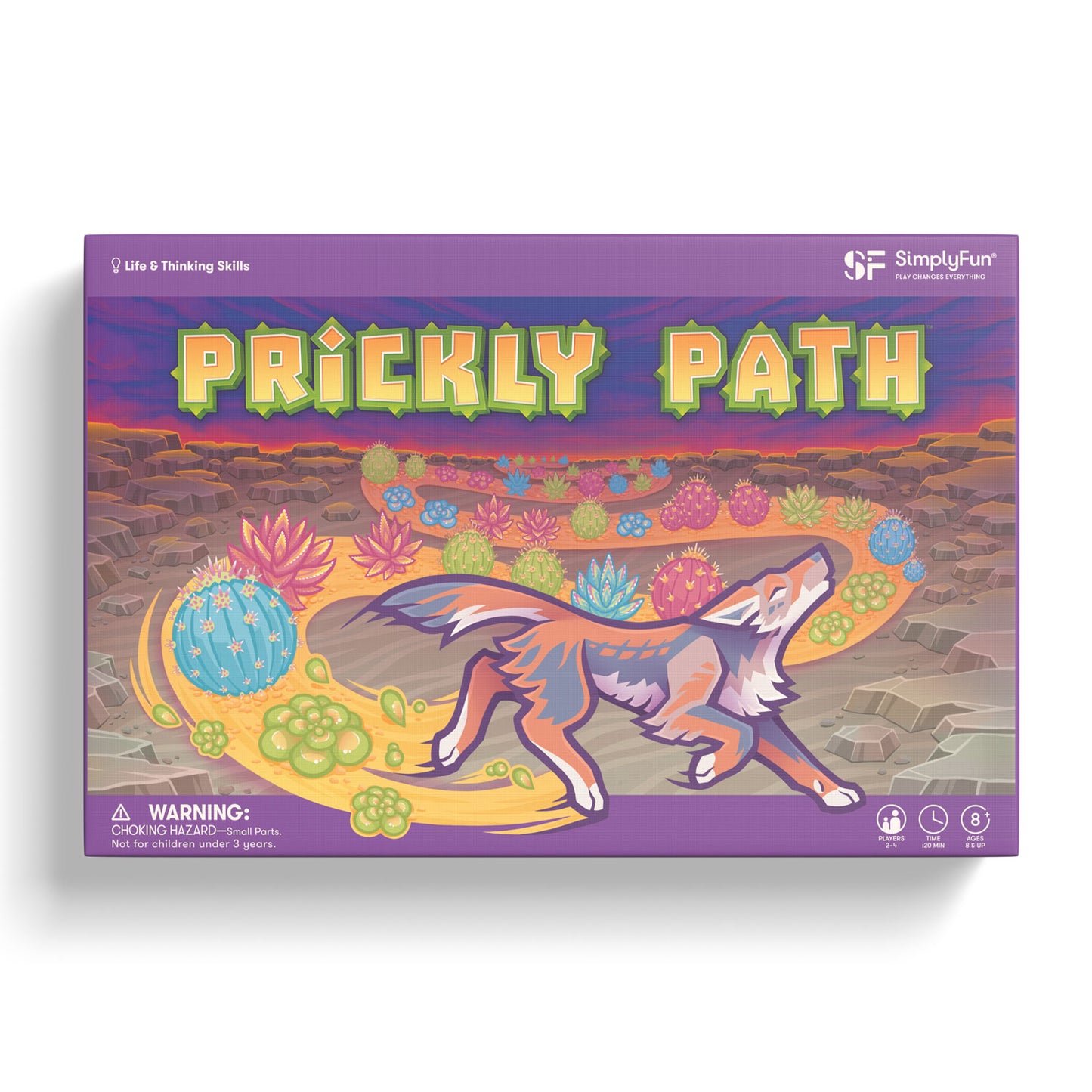
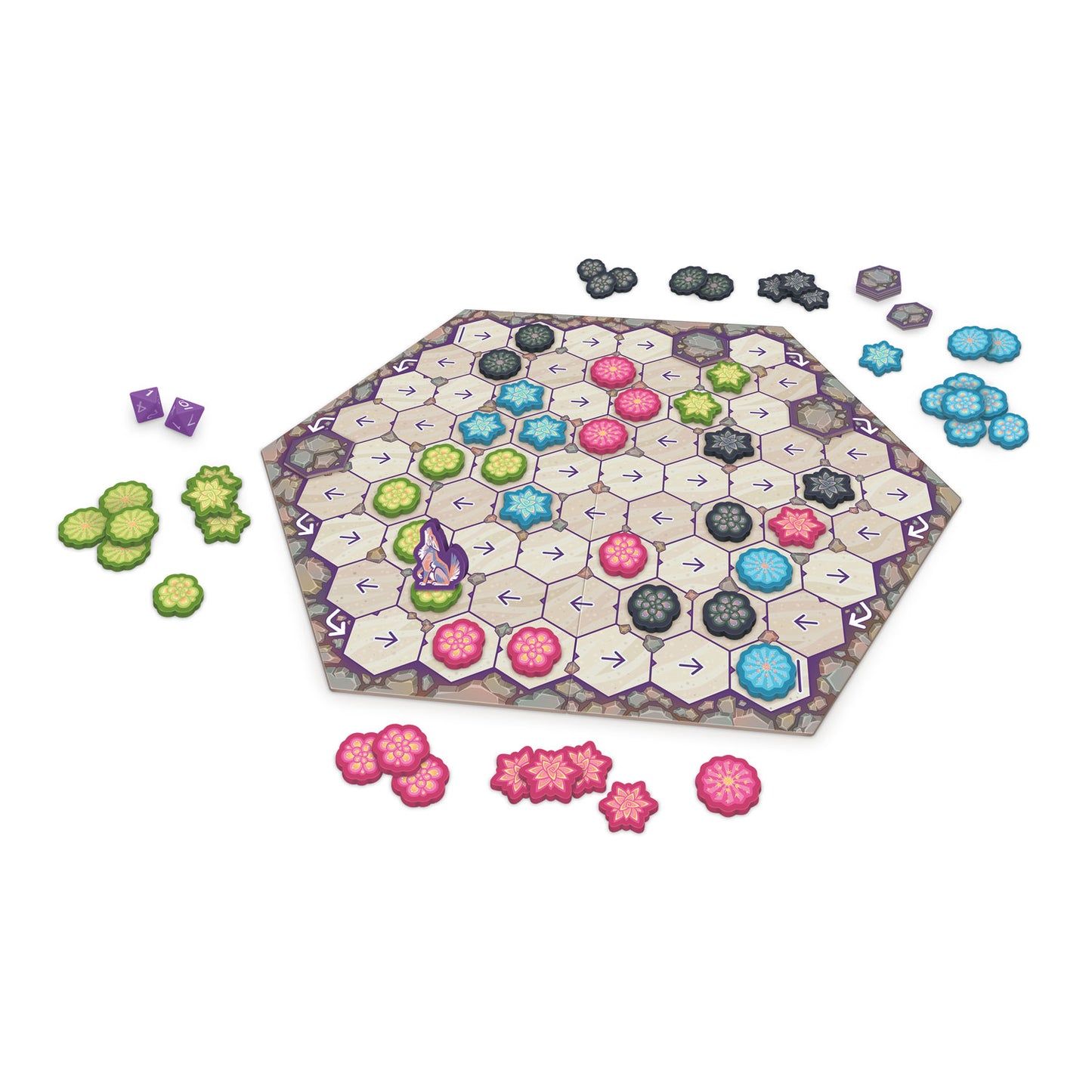
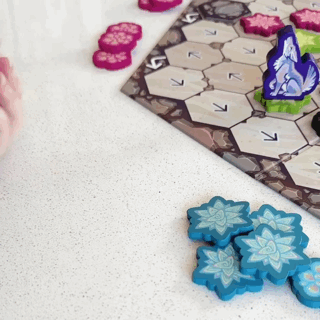
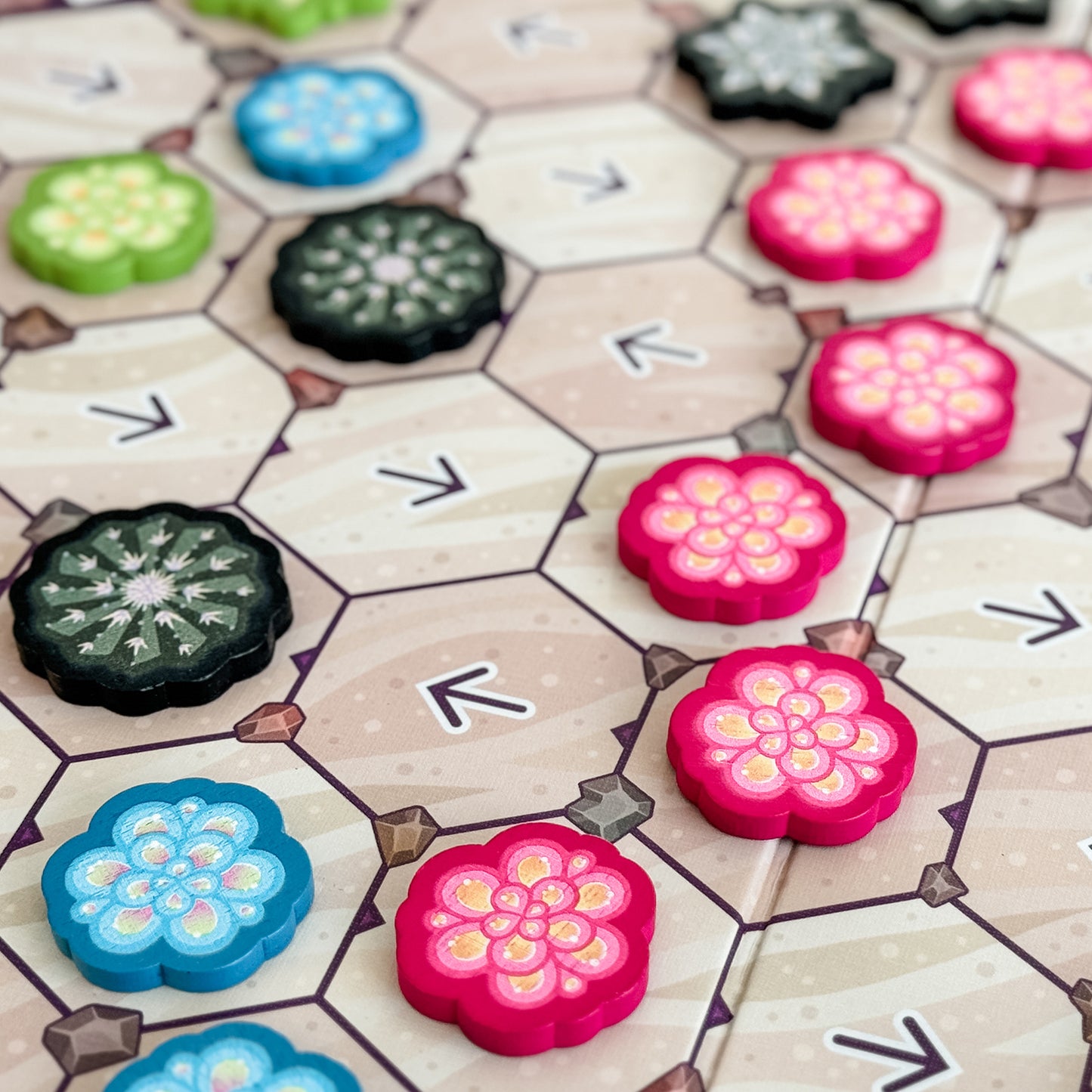
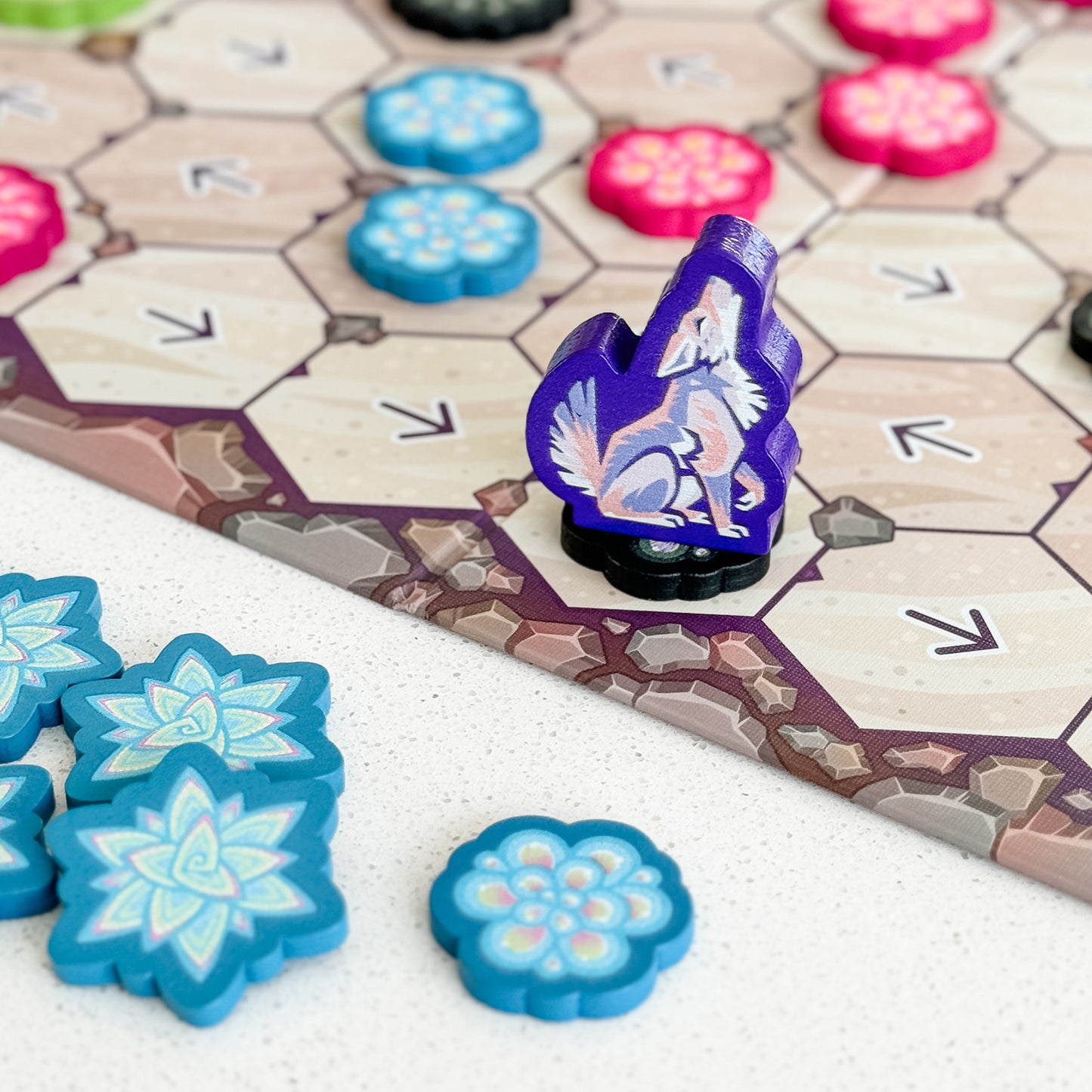
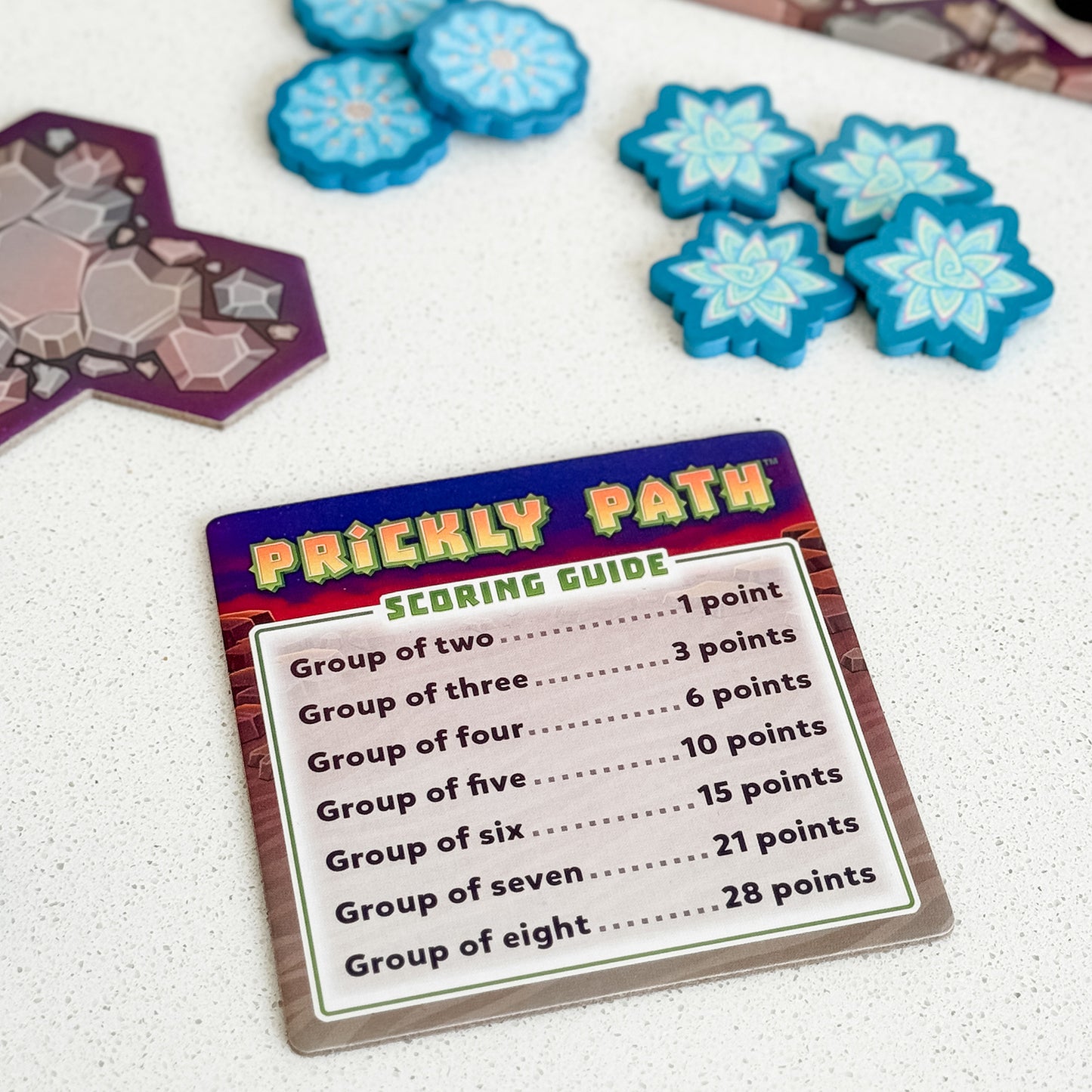
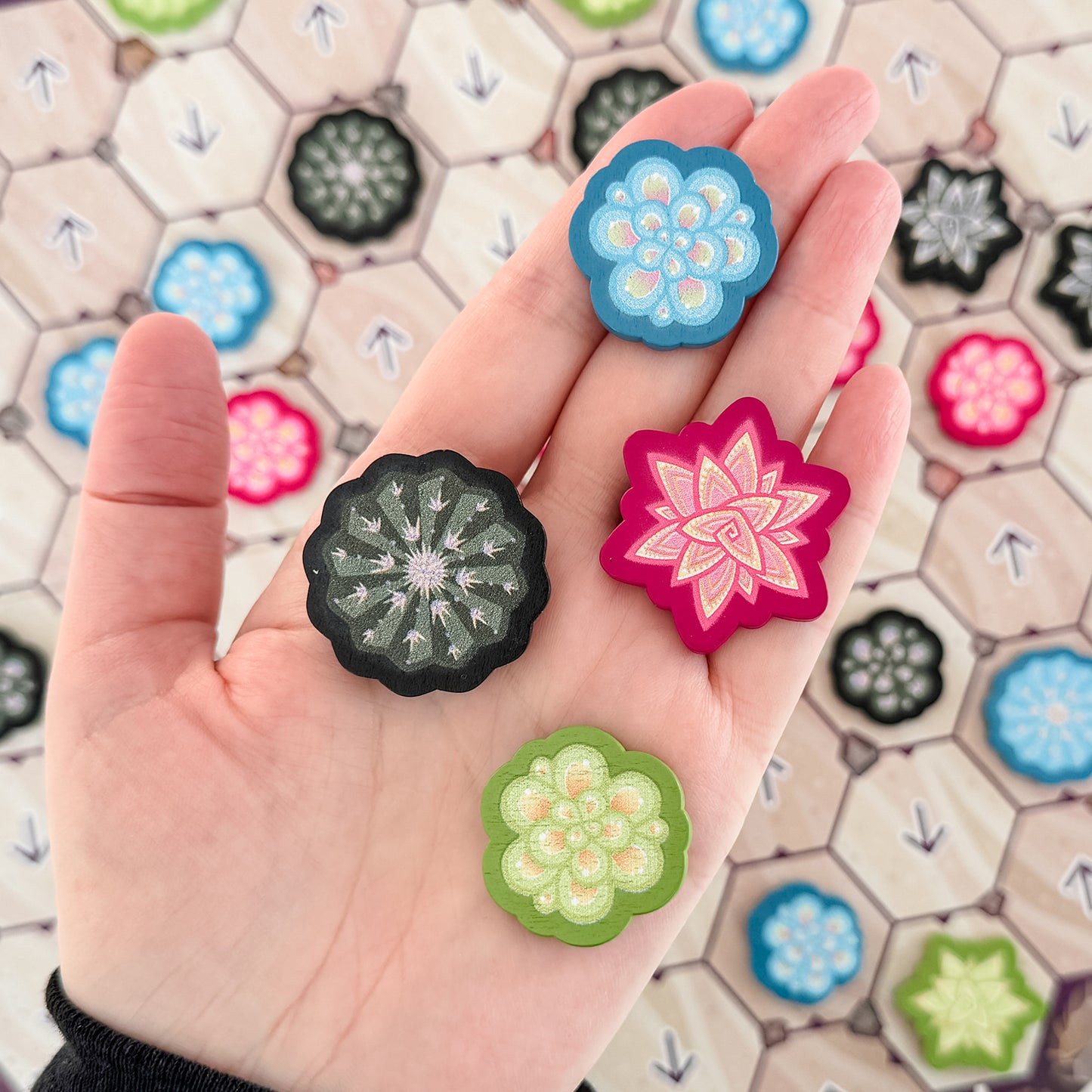
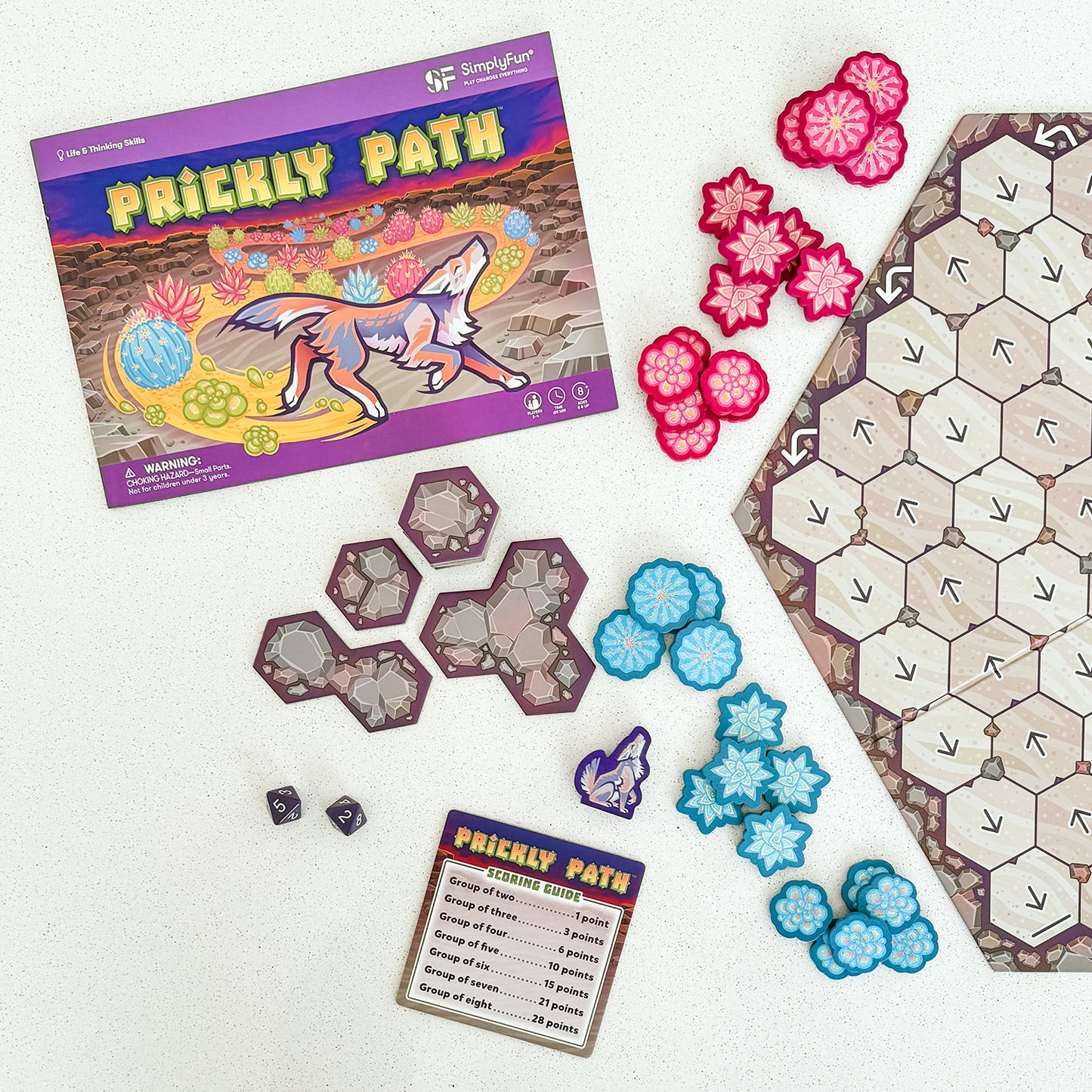




Collapsible content
How to Play
Educational Standards
Core Standard*: Math
Math
- Operations and Algebraic Thinking
- Comprehension and Collaboration : Grade Level 2nd
- Number & Operations in Base 10
- Understand place value. : Grade Level 2nd
- Use place value understanding and properties of operations to add and subtract. : Grade Level 2nd
- Geometry
- Reason with shapes and their attributes. : Grade Levels 2nd, 3rd
Skills
Explore
What Does Child Do To Use Skill In The Game?
After rolling the dice, a player needs to look carefully at the gameboard to find options for moving the coyote in order to play a cactus tile or pass.
How Parents Can Assist Learning
If you notice a child seems to be not looking closely at their options, it may help to encourage children to "Wait. Look. Think." This will help them spend time enough time considering what could happen by moving the coyote with the first or second die.
This will also help with impulsivity and planning. Using such verbal cues can give children a model for approaching future play as well as complex life choices.
Learning Implications and Educator Support
Prickly Path involves spatial reasoning, planning, matching and sequencing as children examine the game board on their turn.
If you notice a child seems to be not looking closely at their options, it may help to encourage children to "Wait. Look. Think." This will help them spend time enough time considering what could happen by moving the coyote with the first or second die.
This will also help with impulsivity and planning. Using such verbal cues can give children a model for approaching future play as well as complex life choices.
Determine
What Does Child Do To Use Skill In The Game?
Based on the roll of the dice, players will consider options they have to place cacti or pass. After comparing options, they will decide where to move the coyote and which cactus to play to improve their score or try to block other players. Alternatively, they will pass so they can roll again.
How Parents Can Assist Learning
See Explore
Learning Implications and Educator Support
As children explore the game board they are simultaneously determining implications and comparing benefits of different options to moving the coyote.
Educators may want to ask children to talk about what they are considering and why one option seems better than others. This may reveal areas of strength or weakness in the child's thinking that can be discussed and, if needed, improved.
Compare
What Does Child Do To Use Skill In The Game?
As game play progresses, players assess whether to make an offensive move by playing a cactus to make or grow a cluster, or make a defensive move in an effort to block other players from making cactus clusters.
How Parents Can Assist Learning
Ask children to describe aloud what options they see to make clusters or block others in order help them identify best options for placing an Elemental. Ask specific questions such as, "Look at these two options. Which would be a better place to put your cactus tile?"
Learning Implications and Educator Support
Comparing in Prickly Path helps children learn situational analysis because they need to consider and compare the consequences of playing a cactus or passing.
Ask children to describe aloud what options they see to pass, make clusters or block others in order help them identify best options for placing an Elemental. Ask specific questions such as, "Look at these two options. Which would be a better place to put your cactus tile?" or "What do you think other players will do if you pass?"
Predict
What Does Child Do To Use Skill In The Game?
Prickly Path requires paying attention to what other players are doing in order to predict where they will want to place cacti in order to build their own clusters.
How Parents Can Assist Learning
How other players place their cacti indicates what clusters they are trying to create. Point this out to younger players to help them predict what their opponent(s) might do next, which can help them strategize their next move.
Learning Implications and Educator Support
Playing Prickly Path helps children develop spatial reasoning skills, situational analysis and perspective changing.
How other players place their cacti indicates what clusters they are trying to create. Point this out to younger players to help them predict what their opponent(s) might do next, which can help them strategize their next move.
Educators can encourage children to discuss their options and to declare whether they want to make an offensive (ex: place a cactus to extend one of their clusters) or defensive (ex: place a cactus to block another player from making a cluster) moving the coyote.
Plan
What Does Child Do To Use Skill In The Game?
Early in the game, players can try to plan for placing cactus in different locations to maximize the creation of clusters. As the game progresses, options for planning diminish.
How Parents Can Assist Learning
No parent assistance required.
Learning Implications and Educator Support
Prickly Path involves a little planning in the first few turns. Players will use spatial reasoning and prediction skills as they decide where to place their cactus in order to 1) create multiple options for cluster development later in game, 2) begin developing clusters quickly, or 3) try to interfere with other players' cluster development.
Educators may want to encourage children to try different approaches to discover which may be more effective.
Solve
What Does Child Do To Use Skill In The Game?
As play progresses the path fills in causing players to increasingly adjust and adapt based on options available during their turn.
How Parents Can Assist Learning
As the game is being learned, children may place cacti or choose to pass in non-strategic ways. If you see this, ask the child to explain their thinking and discuss what they might do differently next time.
The ability to shift strategies based on new information can help children cope with the stresses of change in other areas of their life.
Learning Implications and Educator Support
Prickly Path involves uses of spatial reasoning, predicting and situational analysis. Children learn new information constantly during game play based on the actions of other players. This information directly effects how children strategize and adapt their decision-making on subsequent turns.
*Data compiled from CCSSI ELA Standards, WA Science Standards, and Washington Social Studies Standards
Special Needs
Cognitive
Suggestions for How to Modify Play Experience
Play in partners for children who have cognitive delays to assist with problem solving.
Have children look at the area close to the coyote. Have them identify potential matches with their cacti and determine what numbers would enable them to place a cactus next to another one of their pieces. This helps the child organize their thinking and be pleased if a hoped for number is thrown.
Communication
Suggestions for How to Modify Play Experience
Encourage use of the names of the cacti when each player lays a token. This adds to their vocabulary.
Encourage describing what each play accomplished. "I think I blocked you." or "Good I connected with my barrel cactus."
Sensorimotor
Suggestions for How to Modify Play Experience
Encourage visual motor skills by having the players watch the arrows when a corner is turned. The cacti pieces are small, so children with fine motor concerns may have difficulty manipulating the pieces as the board gets full. Another player can assist if this is the case.
Social Emotional/Behavioral
Suggestions for How to Modify Play Experience
Have children look at the area close to the coyote. Have them identify potential matches with their cacti and determine what numbers would enable them to place a cactus next to another one of theirs. This helps the child organize their thinking and be pleased if a hoped for number is thrown.
Vision
Suggestions for How to Modify Play Experience
Prickly Path is too visually complex for children with low vision.
Hearing
Suggestions for How to Modify Play Experience
Children who are deaf or hard of hearing should be able to play Prickly Path without a problem, once they understand the directions. Use demonstration and gestures to help clarify the directions.
*Data compiled from CCSSI ELA Standards, WA Science Standards, and Washington Social Studies Standards
Autism
Autism Strengths & Interests
Short Summary of Strengths & Interests
- Spatial Reasoning
- Strategic Thinking
- Problem-solving
Is good at matching visual items
Is This Game Appropriate? Yes
Description
Children with this skill will enjoy Prickly Path. The key aspect is matching and connecting similar cacti.
Has a good memory for sensory details, including visual, touch, taste and smell
This game is not appropriate
Has a good memory for words, phrases and dialouge
This game is not appropriate
Has a good memory for pictures, numbers and patterns
Is This Game Appropriate? No
Description
Memory for patterns is not needed, but recognizing similar shapes of the cacti is needed. The larger the group of linked similar cacti the higher the scoring value.
Likes to put things in order or a sequence
Is This Game Appropriate? Yes
Description
Prickly Path is also a sequencing game, as the path winds back and forth across the board. Players also place their cacti in such a way that they are connected, whenever they can.
Learns through visualizing or "replaying" actions in their mind
This game is not appropriate
Likes activities with rules, such as math and phonics
This game is not appropriate
Is very concrete and literal
Is This Game Appropriate? Yes
Description
Pieces are manipulated as the player moves the token, and all options are visible, so the game if very concrete and literal.
Learns in small "chunks" (for example, phone numbers are 3 chunks of number xxx-xxx-xxxx that are combined together)
This game is not appropriate
Is good at nonverbal reasoning and logic
Is This Game Appropriate? Yes
Description
Both the spatial reasoning and strategic thinking required in the game are nonverbal, but children should be encouraged to share their thinking.
Likes spatial problem solving
Is This Game Appropriate? Yes
Description
Players have to examine the board as play continues in order to decide how to place cacti offensively (to connect to similar cacti) or defensively (to block other players from making connections)
Can read well with good vocabulary, though may not fully comprehend content
This game is not appropriate
Likes to use and has good fine motor skill
Is This Game Appropriate? Yes
Description
Placing the tiles involves fine motor skills. The tiles are large enough that most child can perform this.
Likes established routines or set ways of doing things
Is This Game Appropriate? Yes
Description
The game follows one path, so the routine for play is consistent even though the patterns of cacti and stone placement will change each game.
Likes manipulating, constructing or building things
This game is not appropriate
Likes to use and has good musical abilities
This game is not appropriate
Likes to use and has good drawing skills
This game is not appropriate
Autism Special Considerations
Appears to ignore other's communication and/or has difficulty giving eye contact to a communication partner
Is This Game Appropriate for Child with Characteristic? Yes
Can Child with Characteristic Play Game w/o Modification? Yes
Strategies for Developing Compensatory Skills:
The child does not need eye contact or communication to play Prickly Path. Encourage communication by discussing what is happening on the board. Narrate the child's and other players' actions.
Has difficulty understanding complex verbal directions
Is This Game Appropriate for Child with Characteristic? Yes
Can Child with Characteristic Play Game w/o Modification? No
Strategies for Developing Compensatory Skills:
Use demonstration to explain the directions. For example, show the child identical cacti, combined on the board and how points are scored. Throw the die and model how the play varies depending on which die is selected. Omit the skip and skipping stones if these are too difficult for the child to understand.
Uses vocabulary inaccurately or demonstrates echolalia (repeating another's speech)
Is This Game Appropriate for Child with Characteristic? Yes
Can Child with Characteristic Play Game w/o Modification? Yes
Strategies for Developing Compensatory Skills:
Unless echolalia is keeping other players from concentrating on the game, it should not inhibit play.
Gets stuck repeating a verbal topic or physical actions and/or has difficulty attending to others' actions or topic.
Is This Game Appropriate for Child with Characteristic? Yes
Can Child with Characteristic Play Game w/o Modification? Yes
Strategies for Developing Compensatory Skills:
The game is very visual and so the child's actions or verbalizations should not detract from other players attention to the game.
Has difficulty producing speech/communication
Is This Game Appropriate for Child with Characteristic? Yes
Can Child with Characteristic Play Game w/o Modification? Yes
Strategies for Developing Compensatory Skills:
Communication is not necessary to play Prickly Path. Players can concentrate on watching the game play and taking their turn.
Has difficulty sequencing multi-step actions and/or doing complex abstract tasks
Is This Game Appropriate for Child with Characteristic? Yes
Can Child with Characteristic Play Game w/o Modification? No
Strategies for Developing Compensatory Skills:
Use demonstration to explain the directions. For example, show the child identical cacti combined on the board and how points are scored. Throw the dice and model how the play varies depending on which die is selected. Omit the skip and skipping stones, if this is too difficult for the child to understand.
Demonstrates difficulty initiating and maintaining social interactions
Is This Game Appropriate for Child with Characteristic? Yes
Can Child with Characteristic Play Game w/o Modification? No
Strategies for Developing Compensatory Skills:
Use verbal and gestural prompting to help the child initiate their turn and watch others' turns.
Acts out or demonstrates avoidance behaviors when frustrated, overwhelmed, or needs more sensory input.
Is This Game Appropriate for Child with Characteristic? No
Can Child with Characteristic Play Game w/o Modification? No
Strategies for Developing Compensatory Skills:
There are many small pieces that can be thrown and the board can be easily disrupted. Unless the child has strategies for self regulation, Prickly Path may not be a good match. Use any calming strategies that may help the child focus (e.g., fidget toys, hugs, etc.)
Has short attention span for non-preferred activities
Is This Game Appropriate for Child with Characteristic? No
Can Child with Characteristic Play Game w/o Modification? No
Strategies for Developing Compensatory Skills:
Many children with autism prefer puzzles and arranging items. They may find Prickly Path a good game for connecting items. If puzzles are not preferred, this may not be a good match.
Needs sameness or consistent routines and/or has difficulty with transitions from one activity to another
Is This Game Appropriate for Child with Characteristic? Yes
Can Child with Characteristic Play Game w/o Modification? No
Strategies for Developing Compensatory Skills:
The path on the gameboard is consistent across games, but the gameboard changes with each play. Also, players have to make a choice between which die they want to use to make a move. This may be challenging for some children with autism. Use of gestures to point out options, and let the child try each die option before making a decision.
Has difficulty understanding others' feelings, intentions, and the reasons for others' actions.
Is This Game Appropriate for Child with Characteristic? Yes
Can Child with Characteristic Play Game w/o Modification? Yes
Strategies for Developing Compensatory Skills:
Responding to others' feelings is not necessary. Watching others' moves, and anticipating where they may be trying to plant their cacti is needed for planning strategy. Players, however, can play without strategizing if needed.
*Data compiled from CCSSI ELA Standards, WA Science Standards, and Washington Social Studies Standards
Extended Play
Extra Ways to Play the Game
Experiment with shortenting the time for a turn. Placing a time limit of 15 or 30 seconds, to encourage quick thinking and analysis.
Materials Needed
No additional materials needed.
Developmental Benefits
Thinking quickly is often difficult for children with or without disabilities. Gaining practice in reviewing ideas quickly can help children when they are confronting problems later.
*Data compiled from CCSSI ELA Standards, WA Science Standards, and Washington Social Studies Standards
Collapsible content
How to Play Video & Transcript
Prickly Path is great for practicing Strategy as players try to plant cacti on the most beneficial spaces while keeping an eye on what their opponents are doing.
Prickly Path also helps develop Decision Making skills as each turn a player needs to choose between the two numbers rolled on the dice, whether to plant a cactus on the corresponding space or skip, and if planting a cactus, which of their three cacti choices to plant.
Place the gameboard in the middle of the play area where everyone can reach.
Each player selects a color set of cactus pieces and adjusts the number of each cactus type based on the number of players.
Place the coyote pawn on the starting space on the board .
Set 10 one-space-wide skipping stones to the side of the board. Put the rest back in the box.
To determine who goes first, each player rolls the die. The player that rolls the highest goes first. Roll again for any ties. By rolling dice and counting spaces, players take turns placing their cactus pieces on the gameboard. The goal is to try and plant your cactus pieces so they form groups of the same type. The more of the same type in a group, the more points you score. The player with the most points at the end wins! On your turn roll both dice. Looking at the numbers rolled, choose which of the two numbers you wish to use and move the coyote that number of spaces. The coyote moves in the direction indicated by the arrows shown on both the spaces and the board.
If you roll doubles, you may choose to move the coyote pawn any possible number on the die (any number between 1 and 8).
When moving the coyote, do not count any spaces already covered by a cactus or a skipping stone (A). Only count the open spaces with an arrow showing when counting out your movement (B).
When the coyote reaches the end of the board, loop back around to the beginning of the board and continue to follow the arrows.
Planting Cacti
After moving the coyote, you may choose to plant a cactus or skip planting on the space. If you choose to plant a cactus, take one of your cactus pieces and plant it on the space the coyote landed on and then place the coyote back on top of the cactus.
Each player has three different types of cacti to create groups: Succulent, Aloe, and Barrel
To earn points, cactus pieces need to share a color and type with each cactus they touch. Once on a space, pieces may not be moved, so plant carefully.
The larger the group of identical cacti, the more points it is worth.
Skipping
If the results on the dice do not provide you with a good planting location, you may choose to skip it. To skip it, you must first choose one of the numbers to move the coyote and then say, “Skip.” You do not plant a cactus piece. The player on the left now gets the choice to plant one of their cactus pieces on that space or they may also choose to skip.
If that player chooses to plant a cactus piece, they place their chosen piece immediately.
If that player also chooses to skip, then the next player has the option to plant or skip and so on. If all players skip, place a skipping stone on that space and then put the coyote back on top of the stone. That space now remains taken for the rest of the game.
No matter which of the previous situations happens, you get to reroll the dice and take another turn because you did not yet plant a cactus piece. Roll again and move the coyote again and pick a new space to plant your cactus. You may skip only once per turn, so you cannot skip on this roll and must plant a cactus this time.
Skipping can be a great way to save your pieces for a better spot in the future but be mindful of what other players may want to do. It might not be a good space for you, but it could be a great space for someone else. If you run out of skipping stones during your game, no more skipping can take place.
Once you plant a cactus piece, your turn is over and it is the next player’s turn. When all the cactus pieces have been planted the game ends.
Sometimes a player will be out of cactus pieces before the others. If this happens, that player is done but the others continue to play. If you are the last player left in the game, you may not skip.
Scoring
Each grouping of a cactus type in your color will earn you points:
• Groups of two earn 1 point
• Groups of three earn 3 points
• Groups of four earn 6 points
• Groups of five earn 10 points
• Groups of six earn 15 points
• Groups of seven earns 21 points
• And a group of eight earns 28 points.
The game includes a Scoring Card for easy reference during the game.
The player with the most points wins. If tied, the player with the largest grouping of cacti wins. If still tied, look at the next largest group until you have a winner.
See how many cacti you can plant when you play SimplyFun’s Prickly Path.
- Choosing a selection results in a full page refresh.
- Opens in a new window.

